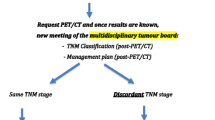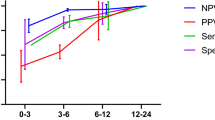Abstract
Purpose
The aim of the study was to evaluate 18F-FDG-PET/CT for the detection of synchronous primaries at initial staging of patients with head and neck squamous cell carcinoma (HNSCC).
Methods
FDG-PET/CT images acquired between March 2001 and October 2007 in 589 consecutive patients (147 women, 442 men; mean age 61.5 years, age range 32–97 years) with proven HNSCC were reviewed for the presence of synchronous primaries. Cytology, histology and/or clinical and imaging follow-up served as reference standard.
Results
FDG-PET/CT showed 69 suspected synchronous primaries in 62 patients of which 56 were finally confirmed in 44 patients. Of the 56 second cancers, 46 (82%) were found in the aerodigestive tract in the following locations: lung (26, 46%), head and neck (15, 17%), oesophagus (5, 9%). Ten second cancers (18%) were located outside the aerodigestive tract (colon, five; stomach, lymphoma, breast, thymus and kidney, one each). Six patients had three synchronous primaries and three patients had four synchronous cancers. Nine synchronous cancers were not detected by PET/CT (four head and neck, two lung, two oesophageal, one gastric). False-positive PET/CT findings were mainly related to benign FDG uptake in the intestine due to benign or precancerous polyps or physiological FDG uptake in other head and neck regions. Overall the prevalence of synchronous second primaries according to the reference standard was 9.5%, of which 84% were detected with FDG-PET/CT. In 80% of the patients, therapy was changed because of the detection of a synchronous primary.
Conclusion
FDG-PET/CT detects a considerable number of synchronous primaries (8.0% prevalence) at initial staging of patients with HNSCC. Synchronous cancers were predominantly located in the aerodigestive tract, primarily in the lung, head and neck and oesophagus. Detection of second primaries has an important impact on therapy. PET/CT should be performed before panendoscopy.


Similar content being viewed by others
References
Jones AS, Morar P, Phillips DE, Field JK, Husband D, Helliwell TR. Second primary tumors in patients with head and neck squamous cell carcinoma. Cancer 1995;75:1343–53.
Hsairi M, Luce D, Point D, Rodriguez J, Brugere J, Leclerc A. Risk factors for simultaneous carcinoma of the head and neck. Head Neck 1989;11:426–30.
Ju DM. A study of the behavior of cancer of the head and neck during its late and terminal phases. Am J Surg 1964;108:552–7.
Warren S, Gates O. Multiple malignant tumors: a survey of literature and statistical study. Am J Cancer 1932;51:1358–414.
Licciardello JT, Spitz MR, Hong WK. Multiple primary cancer in patients with cancer of the head and neck: second cancer of the head and neck, esophagus, and lung. Int J Radiat Oncol Biol Phys 1989;17:467–76.
Stoeckli SJ, Zimmermann R, Schmid S. Role of routine panendoscopy in cancer of the upper aerodigestive tract. Otolaryngol Head Neck Surg 2001;124:208–12.
Fleming AJ Jr, Smith SP Jr, Paul CM, Hall NC, Daly BT, Agrawal A, et al. Impact of [18F]-2-fluorodeoxyglucose-positron emission tomography/computed tomography on previously untreated head and neck cancer patients. Laryngoscope 2007;117:1173–9.
Gordin A, Golz A, Keidar Z, Daitzchman M, Bar-Shalom R, Israel O. The role of FDG-PET/CT imaging in head and neck malignant conditions: impact on diagnostic accuracy and patient care. Otolaryngol Head Neck Surg 2007;137:130–7.
Connell CA, Corry J, Milner AD, Hogg A, Hicks RJ, Rischin D, et al. Clinical impact of, and prognostic stratification by, F-18 FDG PET/CT in head and neck mucosal squamous cell carcinoma. Head Neck 2007;29:986–95.
Gorospe L, Raman S, Echeveste J, Avril N, Herrero Y, Herna Ndez S. Whole-body PET/CT: spectrum of physiological variants, artifacts and interpretative pitfalls in cancer patients. Nucl Med Commun 2005;26:671–87.
Schwartz DL, Rajendran J, Yueh B, Coltrera M, Anzai Y, Krohn K, et al. Staging of head and neck squamous cell cancer with extended-field FDG-PET. Arch Otolaryngol Head Neck Surg 2003;129:1173–8.
Schmid DT, Stoeckli SJ, Bandhauer F, Huguenin P, Schmid S, von Schulthess GK, et al. Impact of positron emission tomography on the initial staging and therapy in locoregional advanced squamous cell carcinoma of the head and neck. Laryngoscope 2003;113:888–91.
Goerres GW, Schmid DT, Gratz KW, von Schulthess GK, Eyrich GK. Impact of whole body positron emission tomography on initial staging and therapy in patients with squamous cell carcinoma of the oral cavity. Oral Oncol 2003;39:547–51.
Wax MK, Myers LL, Gabalski EC, Husain S, Gona JM, Nabi H. Positron emission tomography in the evaluation of synchronous lung lesions in patients with untreated head and neck cancer. Arch Otolaryngol Head Neck Surg 2002;128:703–7.
Brouwer J, Senft A, de Bree R, Comans EF, Golding RP, Castelijns JA, et al. Screening for distant metastases in patients with head and neck cancer: is there a role for (18)FDG-PET? Oral Oncol 2006;42:275–80.
Ng SH, Chan SC, Liao CT, Chang JT, Ko SF, Wang HM, et al. Distant metastases and synchronous second primary tumors in patients with newly diagnosed oropharyngeal and hypopharyngeal carcinomas: evaluation of (18)F-FDG PET and extended-field multi-detector row CT. Neuroradiology 2008;50:969–79.
Atabek U, Mohit-Tabatabai MA, Raina S, Rush BF Jr, Dasmahapatra KS. Lung cancer in patients with head and neck cancer. Incidence and long-term survival. Am J Surg 1987;154:434–8.
Senft A, de Bree R, Hoekstra OS, Kuik DJ, Golding RP, Oyen WJ, et al. Screening for distant metastases in head and neck cancer patients by chest CT or whole body FDG-PET: a prospective multicenter trial. Radiother Oncol 2008;87:221–9.
Slaughter DP, Southwick HW, Smejkal W. Field cancerization in oral stratified squamous epithelium; clinical implications of multicentric origin. Cancer 1953;6:963–8.
Kamel EM, Thumshirn M, Truninger K, Schiesser M, Fried M, Padberg B, et al. Significance of incidental 18F-FDG accumulations in the gastrointestinal tract in PET/CT: correlation with endoscopic and histopathologic results. J Nucl Med 2004;45:1804–10.
Aoki J, Watanabe H, Shinozaki T, Tokunaga M, Inoue T, Endo K. FDG-PET in differential diagnosis and grading of chondrosarcomas. J Comput Assist Tomogr 1999;23:603–8.
Cheran SK, Nielsen ND, Patz EF Jr. False-negative findings for primary lung tumors on FDG positron emission tomography: staging and prognostic implications. AJR Am J Roentgenol 2004;182:1129–32.
Yamada A, Oguchi K, Fukushima M, Imai Y, Kadoya M. Evaluation of 2-deoxy-2-[18F]fluoro-D-glucose positron emission tomography in gastric carcinoma: relation to histological subtypes, depth of tumor invasion, and glucose transporter-1 expression. Ann Nucl Med 2006;20:597–604.
Stoeckli SJ, Steinert H, Pfaltz M, Schmid S. Is there a role for positron emission tomography with 18F-fluorodeoxyglucose in the initial staging of nodal negative oral and oropharyngeal squamous cell carcinoma. Head Neck 2002;24:345–9.
Author information
Authors and Affiliations
Corresponding author
Rights and permissions
About this article
Cite this article
Strobel, K., Haerle, S.K., Stoeckli, S.J. et al. Head and neck squamous cell carcinoma (HNSCC) – detection of synchronous primaries with 18F-FDG-PET/CT. Eur J Nucl Med Mol Imaging 36, 919–927 (2009). https://doi.org/10.1007/s00259-009-1064-6
Received:
Accepted:
Published:
Issue Date:
DOI: https://doi.org/10.1007/s00259-009-1064-6




